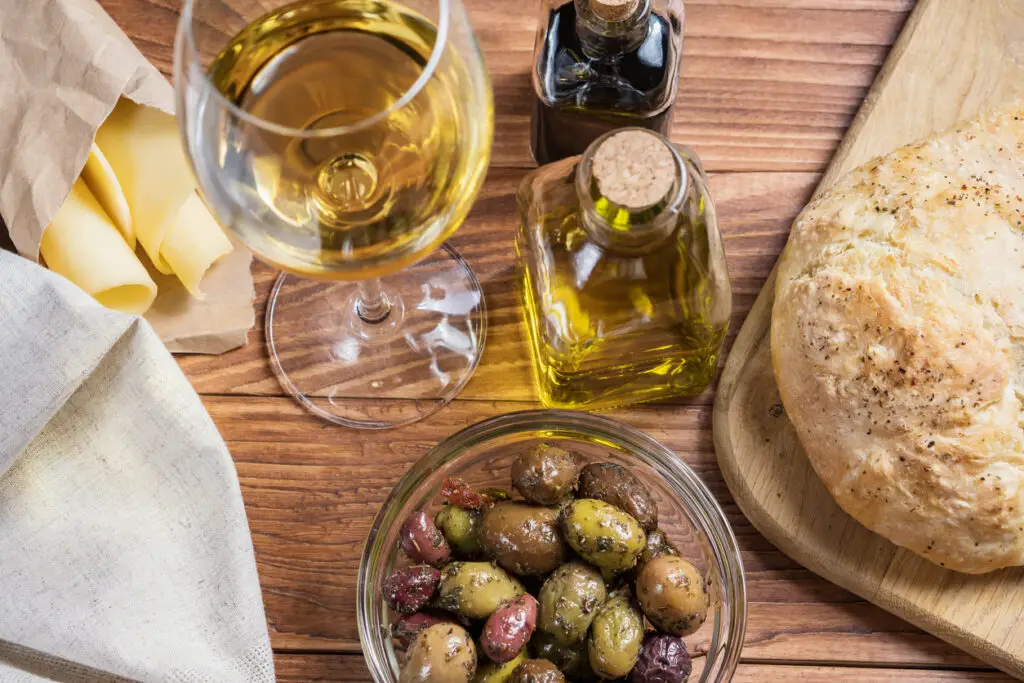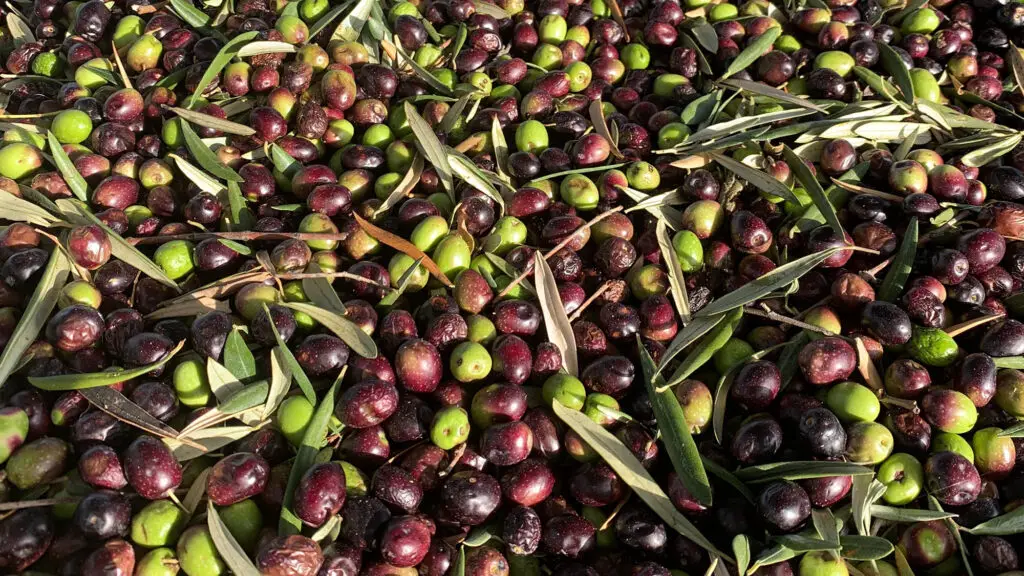We all describe the way wine tastes in various ways. There are certain flavors and aromas we are drawn to and others we avoid. Most people stick to the most common flavors like fruit and spice. There are endless other flavors that can make wine exciting and add a new character to a wine. Olives are commonplace in cuisine around the world. What about wine? Why does wine taste like olives?
Wine may taste like olives because of polyphenol compounds that are found in both grapes and olives. Sulfur in small amounts also gives the impression of olive aromas. When speaking about a wine’s character, black olive may describe the wine’s earthy flavor and slightly tannic texture.
Aromas and flavors in wine are often determined by the same compounds found in other plants. Let’s look at the reasons you may feel like you are drinking a glass of olive juice.
Let’s Talk About Olives
Olives have a distinct flavor that people love or hate. They are commonly eaten plain, added to recipes, or used as an oil. Olives have a very distinctive taste. Many people are drawn to it while others refuse to indulge. However, it can add a lot of complex character to a wine.
Author Note: Green and black olives are produced from the same tree. An olive’s color tells you how ripe it is. Green olives are picked early before they have fully ripened. Black olives are those that were left longer on the tree and picked at peak ripeness.
When olives ripen, the amount of polyphenol compounds they contain lowers. Like grapes, polyphenols are what give olives their tannin.
Green olives will taste more astringent because of their higher levels of polyphenols. Black olives that have ripened will have a reduced percentage of polyphenols and will taste softer and earthier.
Wines that Taste like Olives

Each grape variety has key characteristics that distinguish them from other grapes. There is always some variance depending on where the grape is grown and how the wine is made.
Olive aromas and flavors are often found in cool-climate wines. These tend to have fewer fruit notes. They lean on earthy and vegetal characteristics.
Syrah is a wine that is often described as having olive aromas. Together with its black pepper and dark fruit, the olive adds a nice balance to the wine.
Olive notes can be found in some Californian Cabernet Sauvignon. Primarily from cooler vintages, these wines tend to be savory with less fruit. Think about how delightful olive tapenade on roasted meat tastes.
Aged Pinot Noir is another great example. These wines are highlighted by their earthy and vegetal aromas.
Olive flavors are often showing up in wines from the Rhone Valley and Provence in France.
Do Olive Aromas Mean a Wine is Faulty?
Some people are not accustomed to aromas that do not fall into the mainstream categories like fruit and spice. They may open a bottle and question if it has turned faulty. While a pungent overpowering smell of olive could hint that your wine has gone bad it is rarely the case.
Author Note: Green olive aromas are sometimes imparted on wines from cool climates that have undergone chemical processes through reduction. When wine is fermented sometimes there is a lack of oxygen. This reduction occurs when sulfur atoms complete the chemical bonds instead of the oxygen.
Sulfur has been given a bad reputation but it is naturally found in grapes. You consume large amounts of sulfur in other common foods like dried fruit.
Sulfur compounds can add positive notes to the wine. Bringing complexity and aromas of green olive, mushroom, and truffle.
A bottle of wine might be faulty if the sulfur is too intense and there is a pungent smell of rotten egg, onion, or garlic.
Ways to Tell if a Wine has Gone Bad

While some people do not enjoy the smell or taste of olives it is not a sign that the wine is bad. There a few key ways to tell if a wine is not at its prime. I typically will not harm you to drink a wine that has gone “bad” but it may be an unpleasant experience.
Looking at the wine in your glass can give you a clue. If your wine is cloudy or has started to turn unusually brown it is likely not at its best. This means undergone more than desirable oxidation.
If your wine smells like wet cardboard or dog it is likely faulty. This aroma is likely the cause of cork taint. This happens when the cork becomes unsealed and TCA imparts undesirable flavors in our wine.
Wines can have “funky” smells that make wine interesting and fun in small amounts. However, if you open a bottle to be overwhelmed by the smell of barnyard or Band-Aids beware. This is a common problem when a certain yeast has entered your wine referred to as “Brett”.
A strong smell of sharp sauerkraut or vinegar may mean that too much acetic acid has infiltrated your wine. The acetic acid that contains bacteria turns your wine into vinegar.
Sometimes aromas of applesauce or burnt marshmallow mean that a wine has come in contact with more oxygen than benefits a wine. This means your wine has gone through too much oxidation.
Smelling garlic, cabbage, or burnt rubber could mean reduction has exceeded desirable limits.
Strong aromas can be normal. However, watch out for extremely sharp and abrasive smells and flavors.
Again, these “issues” will not make you sick. It means you may need to run to the store for another bottle you can enjoy.
What Gives Wine its Aroma and Flavor?
Grapes contain many of the same compounds that are in other things we consume. Fermentation is the key process during winemaking that unlocks and develops all of the complex characteristics.
Each type of grape contains different concentrations of compounds lending to key flavors that turn out in wine. They also gain compounds from the environment, air, soil, and growing methods that add new elements
Author Note: Wine contains hundreds of organic chemical compounds like esters, pyrazines, terpenes, thiols, and lactones. Many of these are found in other fruits, vegetables, and foods.
This is why we get the impression of cherries in red wine. Winemakers did not add flavoring or put cherries in the fermentation barrels. Some grapes have the same aroma compounds that cherries contain.
On a rare occasion, nearby plants or environmental factors can influence flavor. Australian red wines often taste of eucalyptus because the airborne oil from the trees attached itself to the skin of the grapes. Wildfires have also been known to add what is called smoke taint to wine.
Smell and Taste

When you smell wine the aroma compounds are carried to your nose when the alcohol evaporates. These are called volatile compounds because they quickly evaporate.
When you drink a glass of wine the first thing you do is inhale the volatile compound aromas. Olfaction is when you take in, or smell, aromas through your nose and your mouth (retronasal olfaction).
Olfaction allows you to determine many more specific aromas. You can identify things like orange marmalade, ripe raspberries, or tart cherries.
The taste is much broader. Your tastebuds differentiate between sensations of sweet, salty, sour, bitter, and umami.
We often think we taste strawberries, but our taste buds are determining that what we are eating is sweet and slightly sour. Our sense of smell is filling in the gaps of what makes a strawberry smell and taste like specifically.
Our sense of smell in particular is strongly linked to memories in our brain. In the setting of drinking wine, we link aromas to what we remember the smells to be or the closest thing we can find to that particular smell.
Conclusion
Wines are often described as having an earthy flavor. This can come across as tasting like olives. This does not mean your wine is bad.
Sulfur compounds can impart smells and flavors of olives in wine. It is one of the many nuances that make wine complex and enjoyable. The next time someone asks you “why does wine taste like olives?” you’ll be able to answer them.
To living a full-bodied life,
Wesley

